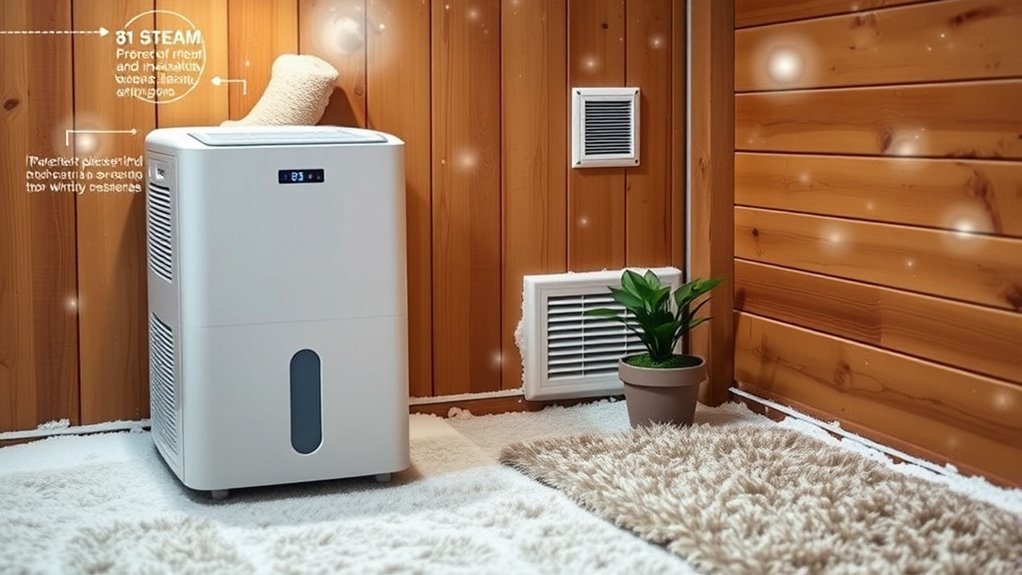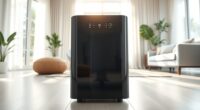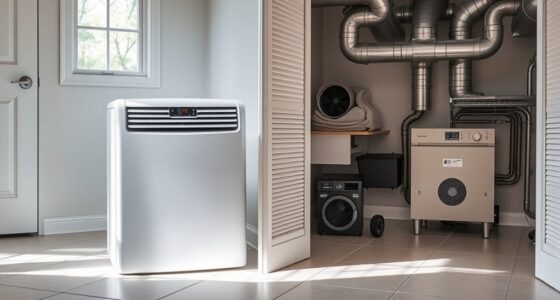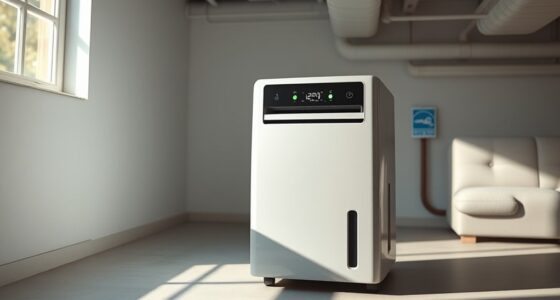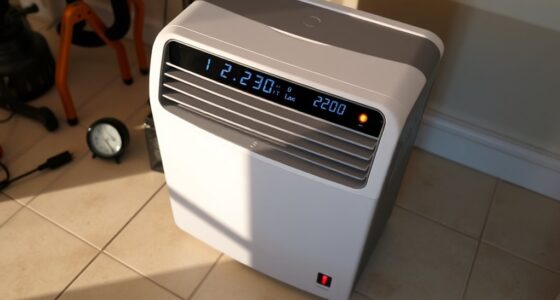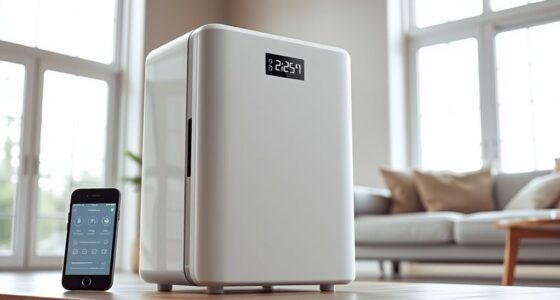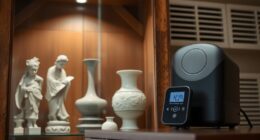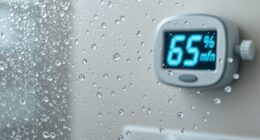To prevent your dehumidifier from freezing up in winter, set it to maintain a humidity level of 40-50%, and avoid operating in very cold spots or on low settings. Place it away from cold drafts and keep it elevated off the floor. Use defrost modes if available, and regularly check humidity levels with a hygrometer. Proper placement and adjustments help keep your unit efficient—continue to explore these tips for ideal performance in winter.
Key Takeaways
- Set the dehumidifier to 40-50% humidity to prevent over-drying and minimize cold buildup.
- Place the unit away from cold drafts and near windows to avoid contact with freezing air.
- Use “defrost” or “low-temperature” modes if available to prevent ice formation.
- Elevate the dehumidifier slightly off the floor to reduce cold surface contact.
- Regularly monitor humidity levels with a hygrometer and turn off the unit in very cold conditions.
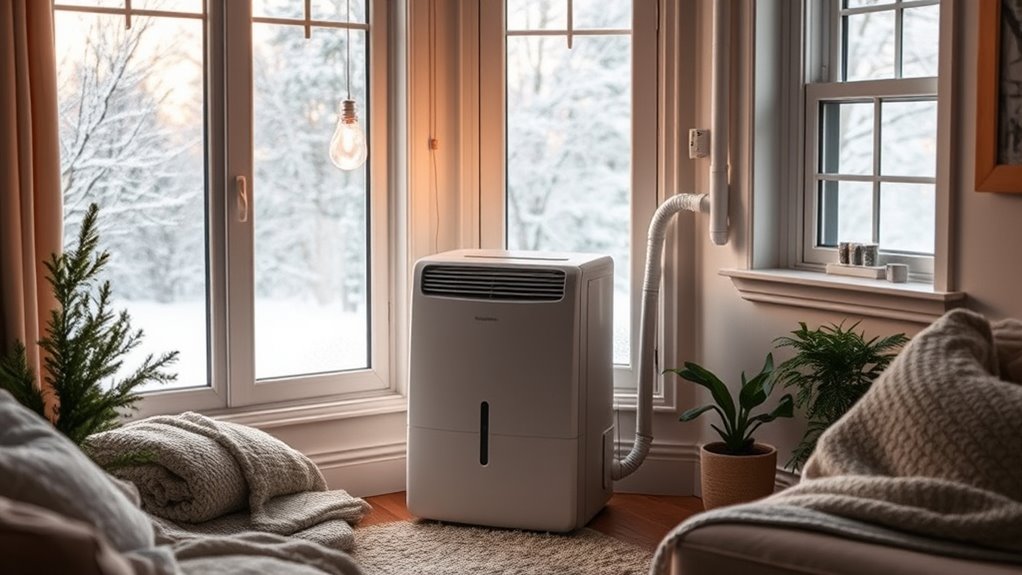
Winter can bring increased humidity levels inside your home, leading to discomfort and potential mold issues. When the air feels damp and musty, it’s a clear sign that humidity control is needed. Using a dehumidifier during the colder months isn’t just about comfort; it’s also about maintaining a healthy living environment. But winter presents unique challenges, such as the risk of the unit freezing up, which can hinder its performance and cause damage. To avoid these issues while keeping your home comfortable and energy-efficient, you need to understand how to properly operate your dehumidifier in winter.
In winter, manage humidity carefully to prevent mold and freezing issues with your dehumidifier.
First, set your dehumidifier to a relative humidity level between 40% and 50%. This range helps balance moisture removal without over-drying the air, which can make your home feel colder and increase heating costs. By maintaining ideal humidity levels, you improve energy efficiency because your heating system doesn’t have to work as hard to compensate for overly dry or damp air. Keep in mind that during winter, the air is naturally drier outside, so your dehumidifier should work less frequently, saving you energy and reducing your bills.
To prevent the unit from freezing, avoid operating it in very cold environments or on excessively low settings. If your dehumidifier has a “defrost” or “low-temperature” mode, activate it. These features help the unit run smoothly in colder conditions by periodically warming the coils to melt any ice that starts to form. Additionally, place the dehumidifier in a spot that’s not exposed to direct cold drafts or near windows where cold air enters. Elevating the unit slightly off the floor can also help, especially if your floors tend to be colder. Proper temperature regulation is essential for optimal dehumidifier performance during winter.
Another important tip is to monitor the humidity levels regularly with a hygrometer. This way, you can adjust the dehumidifier’s settings as needed and avoid overuse, which could lead to unnecessary energy consumption. Remember, a well-maintained filter and clean coils ensure the unit runs efficiently, reducing energy waste and prolonging its lifespan. When you’re not using the dehumidifier, turn it off or unplug it to prevent it from running unnecessarily and consuming power.
Frequently Asked Questions
Can I Use a Dehumidifier Alongside a Humidifier in Winter?
Yes, you can use a dehumidifier alongside a humidifier in winter, but you need to monitor their humidifier compatibility to maintain the right moisture balance. Running both devices requires careful adjustment; the dehumidifier reduces excess moisture, while the humidifier adds moisture where needed. This helps prevent overly dry or damp environments, ensuring comfort and avoiding issues like mold or respiratory discomfort. Keep an eye on humidity levels for ideal results.
How Often Should I Empty the Dehumidifier’S Water Tank During Winter?
When it comes to emptying your dehumidifier’s water tank during winter, don’t let it pile up like a mountain. Check the tank daily or every couple of days, depending on your dehumidifier’s capacity and humidity levels. Regular water tank maintenance guarantees it runs efficiently and prevents overflows. If you’re in a damp area, you might need to empty it more often to keep your space comfortable and dry.
Does a Dehumidifier Increase Energy Bills in Winter?
Using a dehumidifier in winter does increase your energy consumption, which can lead to higher cost implications. While it helps control humidity and prevent mold, running it continuously or at high settings uses more electricity. To minimize costs, set your dehumidifier to a suitable level, guarantee it’s energy-efficient, and only run it when necessary. Proper use helps balance comfort with energy savings, avoiding unnecessary increases in your bills.
Can a Dehumidifier Prevent Mold Growth in Winter?
Sure, because nothing says cozy winter like mold lurking behind your walls. A dehumidifier can actually be your secret weapon for mold prevention by controlling moisture levels. It keeps humidity in check, preventing dampness that mold loves. So, if you want to avoid turning your home into a moldy museum, use your dehumidifier for moisture control—it’s the hero your winter home deserves.
What Safety Precautions Are Necessary for Winter Dehumidifier Use?
When using a dehumidifier in winter, you need to prioritize electrical safety by checking cords and outlets for damage and avoiding water contact. Proper placement is key—place it in a well-ventilated, level spot away from walls and furniture to prevent freezing issues. Always follow manufacturer’s instructions, unplug when not in use, and keep the device dry to guarantee safe and efficient operation during colder months.
Conclusion
So, now that you know how to keep your dehumidifier from freezing, go ahead—embrace the winter chill without turning your home into an ice rink. After all, who wouldn’t want to spend extra on a fancy gadget just to keep it from turning into a frosty sculpture? Remember, a little prevention goes a long way. Stay warm, dry, and keep that dehumidifier happy—because nothing says winter like battling the elements with a tiny, frozen hero.
